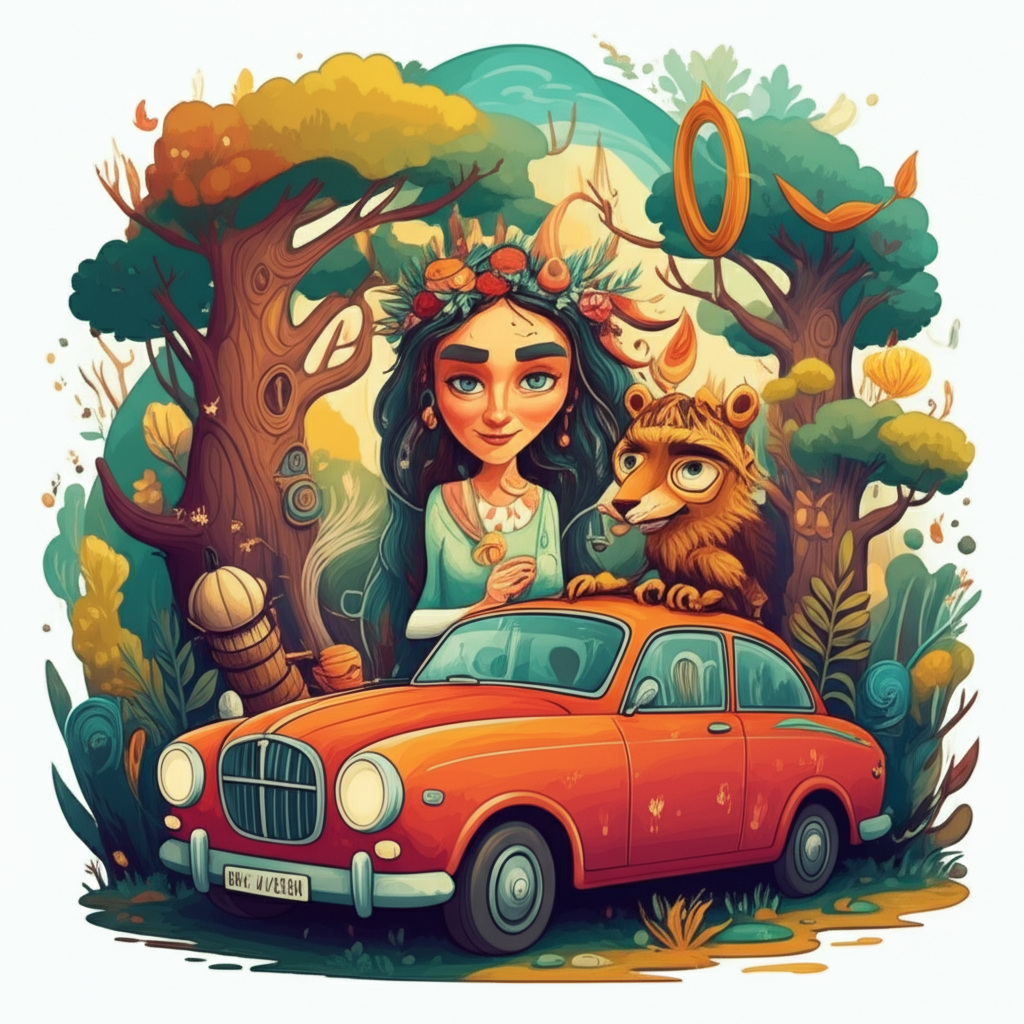
The rustling leaves of an ancient forest, the gnarled roots snaking across the forest floor, the deep, resonant silence broken only by the call of a distant bird – these are the sensory echoes that carry the whispers of old tales. From the vast, verdant expanses of Eastern Europe, particularly in the Slavic lands, comes a rich tapestry of folklore, woven with the threads of nature spirits and ancient deities. Among these, the concept of Mokosh, the Great Mother Goddess, and her earthly manifestations, like the enigmatic Leshy, offer a fascinating glimpse into how ancient peoples understood their world and their place within it.
It is crucial to understand that these are traditional stories, the imaginative interpretations of ancient communities grappling with the mysteries of the natural world. They are not presented as factual accounts, nor are they to be believed or worshipped. Our exploration of these narratives is purely for the purpose of cultural, historical, and educational understanding, recognizing them as profound expressions of human storytelling and a legacy of our shared past.
Roots in a World of Wonder and Respect
The myths surrounding Mokosh and the Leshy are deeply rooted in the lives of ancient Slavic peoples, particularly those who inhabited the dense forests and fertile plains of what is now Eastern Europe. This was a time when human existence was intrinsically linked to the cycles of nature. Agriculture was paramount, and the changing seasons, the bounty of the harvest, and the ever-present threats of drought, flood, and famine dictated the rhythm of life.
In this environment, the world was perceived not as a collection of inanimate objects, but as a vibrant, living entity, imbued with spirits and forces that influenced every aspect of human experience. Deities and spirits were seen as the custodians of the natural world – the heavens, the earth, the rivers, the forests, and the very soil that nourished their crops. Respect, and often a healthy dose of fear, were crucial in maintaining a balance with these perceived powers. This was a worldview where the tangible and the intangible were seamlessly interwoven, where the natural world was a sacred text to be read and understood.
Mokosh: The Weaver of Fate and the Earth’s Embrace
While the Leshy is often seen as a distinct entity, his existence is often linked to the broader pantheon and the overarching influence of figures like Mokosh. Mokosh, meaning "moist" or "damp," was one of the most significant deities in the pre-Christian Slavic pantheon. She was revered as the Great Mother Goddess, the protector of women, childbirth, weaving, and spinning – the very threads of life and destiny. Her domain was the earth itself, the fertile soil that gave life, and the water that sustained it.
Mokosh was often depicted as a stately woman, sometimes with long, flowing hair, symbolizing the abundant growth of nature. She was the weaver of fate, her spindle and thread representing the interconnectedness of all things and the predetermined course of life. She was also associated with rain, snow, and the moisture essential for life, making her a benevolent yet formidable figure whose favor was vital for the prosperity of her people. The stories tell of her presence in the earth, in springs, and in the very fabric of creation.
The Leshy: Guardian of the Verdant Realm
Emerging from the embrace of Mokosh’s earth was the Leshy, the spirit of the forest. The Leshy was a creature of the wild, a shapeshifter who embodied the untamed essence of the woods. Descriptions of the Leshy varied greatly, reflecting the diverse nature of the forests themselves. Some tales depicted him as a tall, imposing figure, his skin like bark, his beard like moss, and his eyes like glowing embers. Others saw him as a small, wizened creature, no taller than a blade of grass, or even as an animal, like a wolf or a bear, capable of blending seamlessly into his surroundings.
Symbolically, the Leshy represented the untamed, unpredictable, and sometimes dangerous aspects of nature. He was the guardian of the forest, its flora and fauna, and the ancient trees. He was said to be able to change his size at will, appearing as a towering giant or shrinking to the size of a leaf. His voice could mimic the rustling of leaves, the howling of wind, or the calls of birds, making him a master of deception. He was often depicted with a green or blue hue, representing the vibrant life of the forest. His presence was felt in the deep woods, far from human settlements, where the ancient trees stood sentinel.
The Narrative of the Forest’s Embrace
Imagine a time when the boundaries between the human world and the spirit world were blurred, when venturing too deep into the forest was an act of both courage and respect. This is where the stories of the Leshy take root.
The villagers, relying on the forest for firewood, game, and medicinal herbs, understood the need for caution. Before entering the deep woods, they would often leave offerings – a piece of bread, a bowl of milk, or a lock of hair – to appease the Leshy and ensure safe passage. It was believed that the Leshy could be both helpful and mischievous, even malevolent, depending on his mood and how he was treated.
A hunter, seeking to track a deer, might find himself lost, his path inexplicably turning back on itself. The trees would seem to shift, the familiar landmarks disappearing. This was the work of the Leshy, playing tricks on those who showed disrespect or ventured too far into his domain without proper reverence. He might lead them in circles, disorient them with strange sounds, or even lure them deeper into the forest where they would be lost forever.
Conversely, if a traveler showed genuine respect, perhaps by clearing fallen branches from a sacred grove or speaking kindly of the forest’s bounty, the Leshy might reveal hidden paths, guide them to abundant hunting grounds, or even warn them of approaching dangers. He was the protector of the forest’s balance, ensuring that no one took more than they needed and that the natural order was maintained.
There were tales of children who wandered too close to the forest’s edge and were spirited away by the Leshy, only to be returned days later, unharmed but with a strange, knowing look in their eyes, as if they had glimpsed the secrets of the wild. These stories served as cautionary tales, emphasizing the importance of respecting the boundaries between the human and natural worlds.
Symbolism: The Wild Heart of Existence
To the ancient Slavs, the Leshy, as an extension of Mokosh’s earthly domain, symbolized the potent and often unfathomable power of nature. He represented the untamed wilderness, a realm that existed beyond human control and understanding. His ability to shapeshift and deceive mirrored the unpredictable nature of the forest itself – its sudden storms, its hidden dangers, and its unexpected beauty.
The Leshy could be interpreted as a personification of the forest’s vitality, its ability to regenerate and endure. He was also a symbol of the wisdom inherent in nature, a wisdom that humans could only hope to glean through observation and respect. His actions, whether benevolent or mischievous, reflected the dual nature of the wilderness – its capacity to sustain life and its potential to overwhelm.
The offerings left to him were not acts of worship in the modern sense, but rather gestures of appeasing a powerful natural force, acknowledging its presence and seeking its favor. This mirrored the broader reverence for Mokosh, who represented the earth’s fertility and the cyclical nature of life and death.
Echoes in the Modern Imagination
In contemporary times, the echoes of these ancient myths continue to resonate. The Leshy, as a spirit of the wild, has found new life in literature, fantasy games, and even some cinematic portrayals. He is often depicted as a formidable guardian of the forest, a being with a deep connection to the natural world, sometimes benevolent and wise, at other times a force of primal chaos. These modern interpretations, while drawing inspiration from folklore, often imbue the Leshy with a more complex, sometimes heroic, or even villainous persona, reflecting contemporary storytelling trends.
Cultural historians and folklorists continue to study these narratives, unraveling the layers of meaning they hold about ancient Slavic beliefs, their relationship with nature, and their understanding of the spiritual realm. The Leshy and the stories of Mokosh serve as valuable windows into a worldview that prioritized harmony with the environment.
A Legacy of Storytelling
As we conclude this exploration, it is vital to reiterate that these are traditional stories, the imaginative expressions of ancient peoples. They are not presented as divine truth or a basis for belief. In Islam, we recognize that only Allah is the true Creator and Sustainer of all that exists.
The tales of Mokosh and the Leshy are a testament to the enduring power of human imagination and the universal need to make sense of the world around us. They are a part of our cultural heritage, a reminder of the diverse ways in which humanity has sought to understand its place within the grand tapestry of existence, through the art of storytelling and the rich symbolism of folklore. These narratives, like the ancient groves they describe, hold within them the echoes of a past, inviting us to reflect on the stories that have shaped human understanding and continue to inspire wonder.





